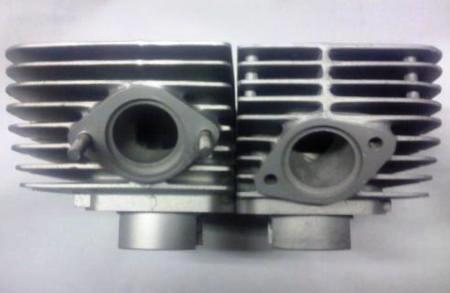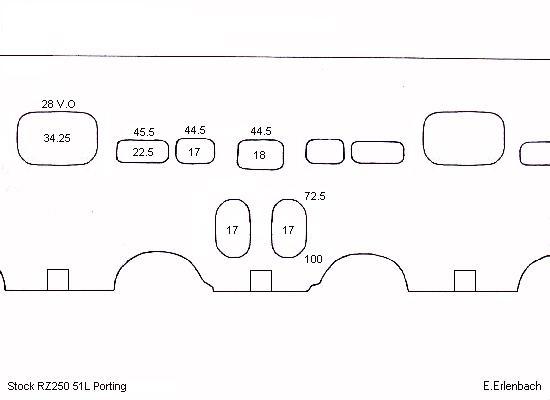|
RD/TZ/LC/RZ PORTMAPS PROJECTS DRAG RACING |
RD250
At least here in
the US probably the least familiar of the Rd250/350/400 family.
On this page I'll try to share some info about the RD250 and their development
from
RD250 to RD250LC to RZ250
The US RD250 was
produced between 1973-75
Here are the port
specs for the US model
The next cylinder redesign
the "2R8" cylinders porting specs looked like this.

(Special Thanks to John
Ritter of Vintage Porting for loaning me a 2R8 cylinder)
When
compared to the later Non US 2R8 cylinders 1978-79 you find A Lot of
differences.
The first thing you notice is the increased cooling fin area, the fins are now
as large as the RD400.
The transfer passages have a much better much more modern tea cup shape..
The Ex port has a much improved floor, gone is the deep valley in the Ex port
floor.
The EX port width was increased to 33.75, the outlet stayed the same
at 37mm but they raised the
outlet RD400 style to take out some of the steep Ex
port angle.
The transfer width and height changed very little and they retained the front to
rear main transfer
port opening taper (to help control short circuiting).
They steepend up the boost port angle a bit and they lengthend the intake port
about 6mm to
unshroud the boost port and increased the reedbox angle.
The rear wall of the main transfer passage (as the air travels up the tunnel)
became straight
instead of curved to increase airflow a bit.
They dropped the intake floor (4mm) like they were doing with the other
RD’s at the time
As well as thicker sleeves, and the use of RD400 style head gaskets.

But they also received the RD250 C/D, designated the 1A2 which was
updated with wider cooling
fins and RD400 style head gaskets but the
porting was the same as the A/B,
the exhaust port still had a small valley in the ex port floor and thin sleeves.
The 2R8 got improved porting, thicker
sleeves, and Yamaha fixed the valley in the ex port floor.
The European E/F was essentially an aircooled RD250 with LC porting and
ignition, and the
"New style" kickstart mechanism.
The clamed power for the E/F went up from 30HP to 32HP
The next
generation was the RD250LC (Liquid Cooled Non-PowerValve)
The RD250LC made a
claimed 34-36HP
The RD250LC porting was essentially the same as the aircooled
2R8 cylinders with the exception
of the a slightly wider and much more oval shaped ex port, slightly higher
transfers by .5mm and
the ex port outlet diam dropping from 37 to 35mm. The ex port floor was also
raised 2mm from 57
to 55 to finally come within a mm of the piston crown at BDC.
And finally the
last of the RD/LC/RZ 250 series the RZ250
(Liquid Cooled with Exhaust Power Valves)

(Special thanks to Jon Wallis and Julian Farnam for
letting me borrow one of his 51L cylinders!!)
Yamaha had learned a lot of
lessons and put them into practice in the RZ250. The intake
was now bridged allowing for a larger intake without being at the expense of
piston life
and the powervalve meant you could have both good low end and better top end.
The
exhaust outlet again dropped in diameter down to 32mm, the main transfers
finally lost
the front to rear taper at the port opening, the auxiliary transfer ports for
the first time now
had “hooks” in them. and the RZ250 unlike it’s bigger brother the 350 also
had a single
large Boyesen port to the inner auxiliary transfer ports. Hp went up by as much
as 12hp.